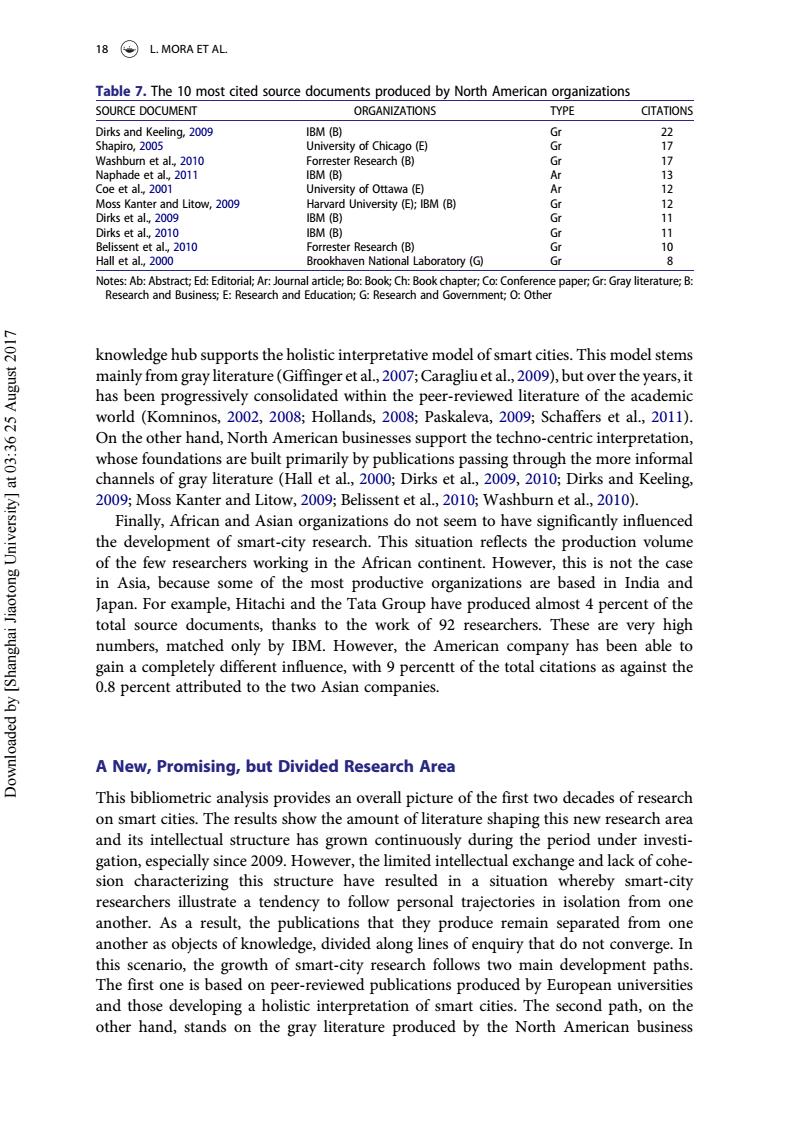正在加载图片...

18©L.MORA ET AL. Table 7.The 10 most cited source documents produced by North American organizations SOURCE DOCUMENT ORGANIZATIONS TYPE CITATIONS Dirks and Keeling,2009 IBM (B) Gr 22 Shapiro,2005 University of Chicago(E) Gr 17 Washburn et al.,2010 Forrester Research (B) Gr 17 Naphade et al.,2011 IBM (B) Ar 13 Coe et al.,2001 University of Ottawa (E) Ar 12 Moss Kanter and Litow,2009 Harvard University (E);IBM(B) 12 Dirks et al.,2009 IBM (B) r 1 Dirks et al.2010 IBM (B) 11 Belissent et al.2010 Forrester Research(B) Gr 10 Hall et al.,2000 Brookhaven National Laboratory (G) Gr 8 Notes:Ab:Abstract;Ed:Editorial;Ar:Journal article;Bo:Book;Ch:Book chapter;Co:Conference paper;Gr:Gray literature;B: Research and Business;E:Research and Education;G:Research and Government;O:Other knowledge hub supports the holistic interpretative model of smart cities.This model stems 1snany mainly from gray literature(Giffinger et al.,2007;Caragliu et al.,2009),but over the years,it has been progressively consolidated within the peer-reviewed literature of the academic world (Komninos,2002,2008;Hollands,2008;Paskaleva,2009;Schaffers et al.,2011). On the other hand,North American businesses support the techno-centric interpretation, whose foundations are built primarily by publications passing through the more informal channels of gray literature(Hall et al.,2000;Dirks et al.,2009,2010;Dirks and Keeling, 2009;Moss Kanter and Litow,2009;Belissent et al.,2010;Washburn et al.,2010). Finally,African and Asian organizations do not seem to have significantly influenced the development of smart-city research.This situation reflects the production volume of the few researchers working in the African continent.However,this is not the case in Asia,because some of the most productive organizations are based in India and Japan.For example,Hitachi and the Tata Group have produced almost 4 percent of the total source documents,thanks to the work of 92 researchers.These are very high numbers,matched only by IBM.However,the American company has been able to gain a completely different influence,with 9 percentt of the total citations as against the 0.8 percent attributed to the two Asian companies. 花o P A New,Promising,but Divided Research Area This bibliometric analysis provides an overall picture of the first two decades of research on smart cities.The results show the amount of literature shaping this new research area and its intellectual structure has grown continuously during the period under investi- gation,especially since 2009.However,the limited intellectual exchange and lack of cohe- sion characterizing this structure have resulted in a situation whereby smart-city researchers illustrate a tendency to follow personal trajectories in isolation from one another.As a result,the publications that they produce remain separated from one another as objects of knowledge,divided along lines of enquiry that do not converge.In this scenario,the growth of smart-city research follows two main development paths. The first one is based on peer-reviewed publications produced by European universities and those developing a holistic interpretation of smart cities.The second path,on the other hand,stands on the gray literature produced by the North American businessknowledge hub supports the holistic interpretative model of smart cities. This model stems mainly from gray literature (Giffinger et al., 2007; Caragliu et al., 2009), but over the years, it has been progressively consolidated within the peer-reviewed literature of the academic world (Komninos, 2002, 2008; Hollands, 2008; Paskaleva, 2009; Schaffers et al., 2011). On the other hand, North American businesses support the techno-centric interpretation, whose foundations are built primarily by publications passing through the more informal channels of gray literature (Hall et al., 2000; Dirks et al., 2009, 2010; Dirks and Keeling, 2009; Moss Kanter and Litow, 2009; Belissent et al., 2010; Washburn et al., 2010). Finally, African and Asian organizations do not seem to have significantly influenced the development of smart-city research. This situation reflects the production volume of the few researchers working in the African continent. However, this is not the case in Asia, because some of the most productive organizations are based in India and Japan. For example, Hitachi and the Tata Group have produced almost 4 percent of the total source documents, thanks to the work of 92 researchers. These are very high numbers, matched only by IBM. However, the American company has been able to gain a completely different influence, with 9 percentt of the total citations as against the 0.8 percent attributed to the two Asian companies. A New, Promising, but Divided Research Area This bibliometric analysis provides an overall picture of the first two decades of research on smart cities. The results show the amount of literature shaping this new research area and its intellectual structure has grown continuously during the period under investigation, especially since 2009. However, the limited intellectual exchange and lack of cohesion characterizing this structure have resulted in a situation whereby smart-city researchers illustrate a tendency to follow personal trajectories in isolation from one another. As a result, the publications that they produce remain separated from one another as objects of knowledge, divided along lines of enquiry that do not converge. In this scenario, the growth of smart-city research follows two main development paths. The first one is based on peer-reviewed publications produced by European universities and those developing a holistic interpretation of smart cities. The second path, on the other hand, stands on the gray literature produced by the North American business Table 7. The 10 most cited source documents produced by North American organizations SOURCE DOCUMENT ORGANIZATIONS TYPE CITATIONS Dirks and Keeling, 2009 IBM (B) Gr 22 Shapiro, 2005 University of Chicago (E) Gr 17 Washburn et al., 2010 Forrester Research (B) Gr 17 Naphade et al., 2011 IBM (B) Ar 13 Coe et al., 2001 University of Ottawa (E) Ar 12 Moss Kanter and Litow, 2009 Harvard University (E); IBM (B) Gr 12 Dirks et al., 2009 IBM (B) Gr 11 Dirks et al., 2010 IBM (B) Gr 11 Belissent et al., 2010 Forrester Research (B) Gr 10 Hall et al., 2000 Brookhaven National Laboratory (G) Gr 8 Notes: Ab: Abstract; Ed: Editorial; Ar: Journal article; Bo: Book; Ch: Book chapter; Co: Conference paper; Gr: Gray literature; B: Research and Business; E: Research and Education; G: Research and Government; O: Other 18 L. MORA ET AL. Downloaded by [Shanghai Jiaotong University] at 03:36 25 August 2017